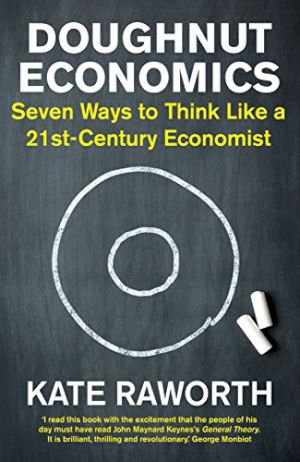11 April 2018
Doughnut Economics
Seven Ways to Think Like a 21st‑Century Economist
Kate Raworth
2017, Random House Business Books, 384 pages,
ISBN 9781847941381
Reviewer: Ian Bright

This is a book worth reading: it has several well thought-out and clearly presented arguments on issues that might affect how economics and economists relate to society. The author also argues economics is taught in a way that actually discourages thinking because people are not encouraged to question the models they are first taught.
Raworth is a supporter of the Rethinking Economics movement. But this book goes further still: Raworth argues that economics is broken, that it has failed to predict (let alone prevent) financial crises, and that it has outdated theories and blind spots.
Raworth argues that seven things need to change. First, economists must shift their focus from GDP to account for environmental effects. The title of the book comes from a diagram suggesting growth must be sufficient to meet basic needs but not so great as to deplete finite resources. Growth bounded by an inner ring of necessity and an outer ring of resource depletion gives the image of a doughnut.
Second, there should be a realisation that economic analysis should be considered as only part of a wider set of ways to examine issues in society. Third, remove the idea of entirely rational thinking. Fourth, embrace systems thinking. Fifth, pay attention to inequality. Sixth, pay attention to environmental deterioration. Seventh, recognise growth alone cannot meet many societal needs.
I agree with many of the arguments and there are interesting interpretations of how economic thought has developed. However, I also believe that many of the concerns raised by Raworth are already widely and actively discussed in mainstream economics.
For example, Raworth writes that, before the 2008 financial crisis, regulators “worked on the assumption that networks always serve to disperse risk” and that “the regulations they devised only monitored the nodes of the network – individual banks – rather than overseeing the nature of their interconnections.” But we know that is not the whole story. Several economists were warning of systemic risk and the Spanish banking authorities were arguing for variable capital requirements because they were worried about this.
Raworth also writes: “Inequality features only as a peripheral concern in the world of equilibrium economics.” Yes, that’s probably true from a theoretical point of view – but that underplays work by economists such as Atkinson who covered inequality from the 1980s perspective.
Raworth’s referencing of Elinor Ostrom’s work and the need for more humility from economists when analysing problems and to understand why society has developed the resource allocation system that currently exists echoes the opinions of Dani Rodrik in his book Economic Rules and Esther Duflo in her essay “The economist as plumber”. The calls for more system-based thinking are already being met in various places, including the Bank of England.
Part of my disagreement with the book’s argument is that it confuses what economists talk and think about with economic policy. But Raworth seems to acknowledge this. Writing on inequality, Raworth notes the “frustration” of IMF economists who wrote in a 2014 paper that “the notion of a trade-off between redistribution and growth seems deeply embedded in policymakers’ consciousness”. Note that the economists were frustrated because the policy makers appeared deaf to the recommendations of professional economists.
A key argument in the book, it appears, is that the way economics is taught needs to be changed to highlight many of the deviations from standard theory. I do not know how economics is taught nowadays but recognise that much is being done to make the economics curriculum more relevant. The CORE programme is a prime example.
For professional economists, this book provides a good overview of issues that need to be addressed to make economics relevant and useful to their everyday work and society at large.
